Perfect oven-roasted turkey is easy to dish up for family meals and holidays with this easy, tried, and true roast turkey recipe! This is one of the easiest ways to ensure your holiday turkey turns out beautifully browned, tender, moist, and super tasty!

Easy Holiday Roasted Turkey
Since both my husband and I love to cook, you know that we love to host gatherings whenever we can. And when we do, we know that using these tips and tricks will result in a perfectly roasted turkey!
Jump to:
- Easy Holiday Roasted Turkey
- 🥘 Ingredients
- 🔪 How To Roast A Turkey In The Oven
- ❓ Recipe FAQs
- How Do I Properly Thaw A Frozen Turkey?
- Can I Thaw My Turkey At Room Temperature?
- What Temperature Should I Roast My Turkey At?
- How Long Do You Cook Turkey?
- Should I Cover My Turkey While Cooking?
- Why Should I Baste My Turkey?
- What Temperature Is Turkey Done Cooking At?
- Where Do I Check The Temperature of Roasted Turkey?
- How Long Should My Oven Roasted Turkey Rest Before Serving?
- What Do I Do With Turkey Leftovers?
- 🦃🥧🍂 Great Thanksgiving Collections
- 📖 Recipe Card
- 💬 Comments & Reviews
🥘 Ingredients
- Turkey - 14-pound whole turkey, fully thawed.
- Butter - 1 cup salted butter, melted.
- Chicken Bullion - 4 cubes; I prefer the Knorr brand.
- Smoked Paprika - ½ tablespoon smoked or regular paprika.
- Orange (optional) - 1 large navel orange, quartered.
- Thyme (optional) - 3-4 sprigs of fresh thyme.
- Chicken Broth - 2 cups of chicken broth or water.
*Be sure to see the free printable recipe card below for ingredients, exact amounts & instructions with tips!*
🔪 How To Roast A Turkey In The Oven
You will need a roasting pan, a baster, and an instant-read temperature probe.
Prep, Season & Stuff The Turkey
Step 1: Prep the oven and pan. Preheat your oven to 450°F (232°C/Gas Mark 8). Move your oven rack down as needed to fit your pan and turkey. Then, place a roasting rack or tray in your large roasting pan.
Step 2: Prep the turkey. Remove the thawed 14-pound turkey from the packaging. Remove any packages in the body cavity (neck, gizzards, heart, and liver are usually inside - some turkeys also have a package of gravy base). Rinse the turkey inside and out, place it in the roasting pan breast side up, and then pat it dry.
Step 3: Make a paste. In a small bowl, combine 1 cup melted butter with 4 cubes of chicken bullion and ½ tablespoon of smoked or regular paprika. Break apart the cubes and mash them to make a paste.
Step 4: Season the turkey. Using the paste, coat the outside of the turkey as well as inside the body cavity (whether or not you will be stuffing the turkey, it adds sensational flavoring!). Start with massaging the paste into the breast and working over the legs, wings, back, and then the remaining paste inside the turkey.
Step 5: Optional stuffing or oranges: Stuff your turkey (optional) with prepared stuffing. *I do not cook our stuffing this way, as the turkey cooks more evenly when left open.
(optional) Place a quartered 1 large orange and 4 sprigs thyme herbs inside the cavity for aroma and flavoring.
Step 6: Add the broth. Pour 2 cups chicken broth into the bottom of the roasting pan (water will work too; water or broth will combine with the drippings from your roasting turkey and can be used for turkey gravy base).
Roast, Rest & Serve The Turkey
Step 7: Roast the turkey. Leave your turkey uncovered and place the roasting pan with seasoned turkey into the oven. Reduce the oven temperature to 350°F (175°C/Gas Mark 4). Cook for 13 minutes per pound without stuffing - or 15 minutes per pound with stuffing.
Step 8: Baste the turkey. Every 45 minutes, remove the turkey from the oven, baste it with the drippings, and then return it to the oven. Continue cooking, repeating as necessary. Close the oven while basting to keep your oven temperature steady for proper roasting time.
Step 9: Temp the turkey for doneness. Remove your turkey from the oven when the internal temperature at the thickest point of the turkey thigh meat reaches 155-160°F (68-71°C).
Step 10: Rest, carve, and serve. Carefully transfer the cooked turkey to a cutting board or serving platter. Cover loosely with aluminum foil, then save the drippings for gravy (if desired).
Allow your turkey to rest for approximately half the roasting time (ex. 1 ½ hours resting time for a 3-hour roasting time).
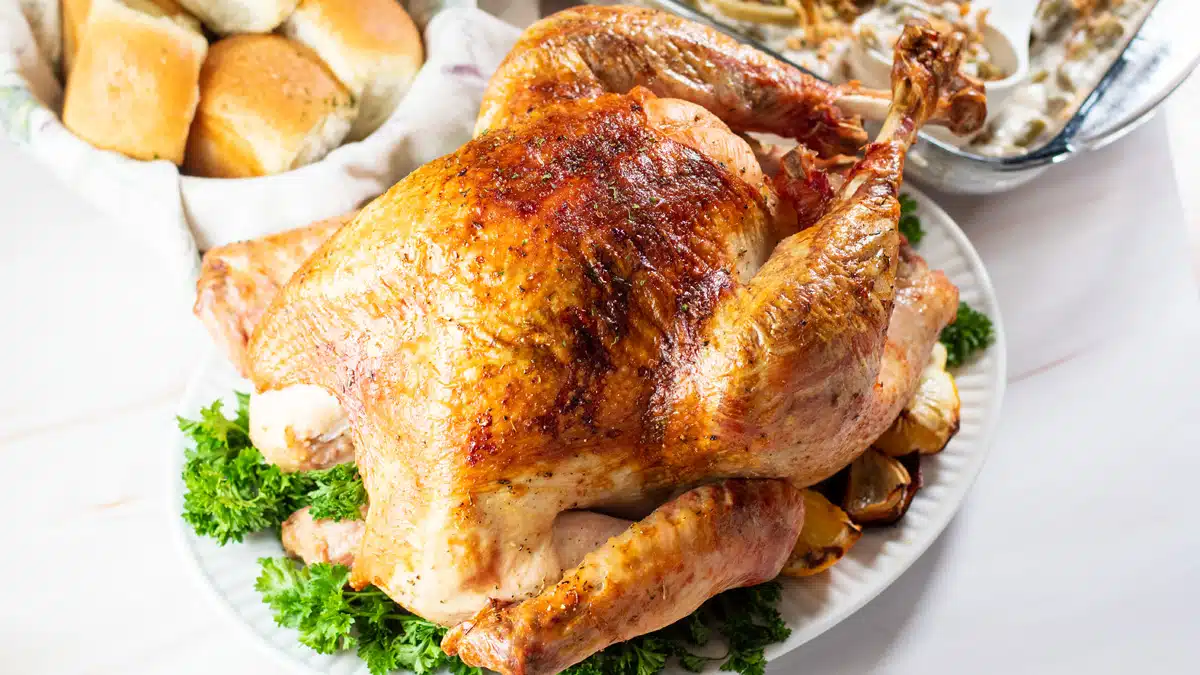
❓ Recipe FAQs
Here are some quick answers to the most commonly asked questions about properly roasting a turkey.
How Do I Properly Thaw A Frozen Turkey?
Thawing times for a frozen turkey are based on weight increments. For every 5 pounds of turkey, allow 24 hours to thaw in a refrigerator (ex, thaw a 20-pound turkey for four days refrigerated).
For every pound of turkey, allow 30 minutes to thaw in cold water that is refreshed every 30 minutes (refill with cold water to avoid the water temperature becoming tepid - see notes in next section).
Can I Thaw My Turkey At Room Temperature?
Thawing should be done in the refrigerator or cold water for safe eating. When left on the counter (or in cold water in the sink overnight), bacteria can breed in temperatures ranging from 40-140°F (4-60°C).
The skin and outer layer of meat can be in this unsafe temperature range when left out either on the countertop to thaw or in a sink filled with water.
See my complete guide to properly thawing turkey to answer all of your questions before the holidays!
What Temperature Should I Roast My Turkey At?
There are differing opinions, but the best temperature to roast your turkey at is either 325°F (162°C) or 350°F (175°C).
*I prefer to roast turkey at 350 F (175°C), as noted in the recipe instructions. **325°F (162°C) is the lowest safe temperature to roast a turkey at, as recommended by the USDA.
How Long Do You Cook Turkey?
Generally speaking, a turkey that has not been stuffed needs 13 minutes per pound to cook thoroughly. When the turkey is not stuffed, the body cavity is left open, allowing the turkey to cook from the inside and outside.
This results in a faster cooking time. If you have stuffed the turkey, it will need about 15 minutes per pound to cook.
You can also ensure a thoroughly cooked turkey by removing the wings and legs or by cutting at the thigh joint, allowing the thigh quarter to fall away from the body. However, both of these options affect presentation at holiday meals.
Leaving your turkey un-trussed will also help to make sure that it cooks evenly, but with the appropriate resting time (as the photo shows on this page), you can leave the turkey whole, trussed and all, with beautiful results!
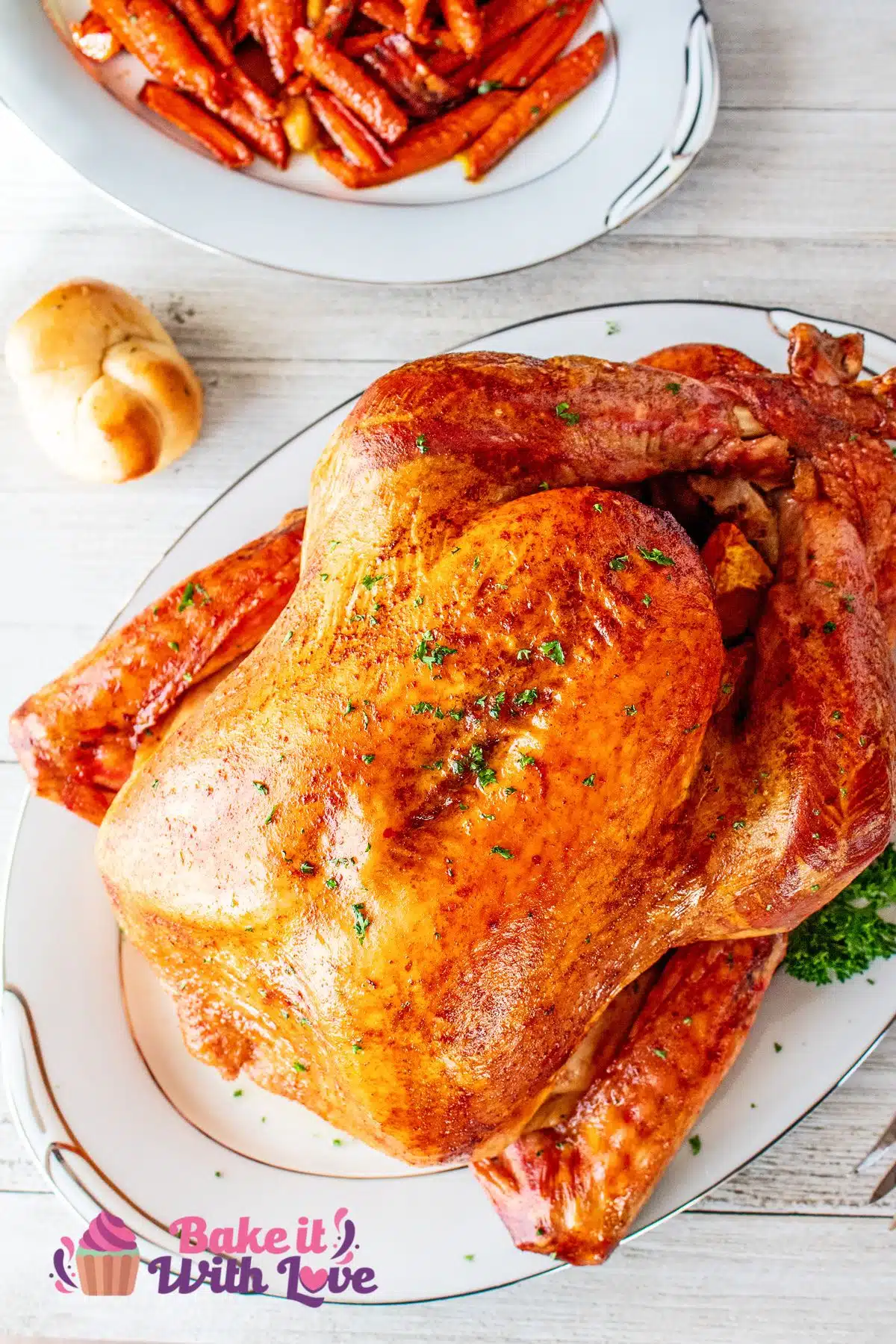
Should I Cover My Turkey While Cooking?
Roast your seasoned turkey uncovered. I recommend covering the turkey with aluminum foil at a certain point, approximately ⅔ of the way into cooking.
You can cover the turkey earlier if the turkey breast appears to be getting too cooked and you are worried about over-cooking the skin or drying out the meat.
When you do cover the turkey with aluminum foil, it should be loosely draped over the top of the turkey. The aluminum foil does not need to be placed on tightly or wrapped securely around the roasting pan edges.
Why Should I Baste My Turkey?
Basting allows the surface of the turkey to cool, which slows the cooking process and allows the turkey parts to cook at close to the same speed. This way, your breast meat, legs, thighs, and all of the turkey are cooked through evenly when done.
It also returns the liquid from the turkey drippings to the surfaces that are being cooked. This helps to ensure a moist turkey breast.
What Temperature Is Turkey Done Cooking At?
Your turkey is done roasting when the internal temperature reaches 155-160°F (68-71°C). This is the best time to remove your oven-roasted turkey and allow it to rest.
The turkey will continue to cook during the resting period. This is called 'carryover cooking'.
Where Do I Check The Temperature of Roasted Turkey?
Check your turkey's temperature with an instant-read meat thermometer. Temp the turkey at the thickest portions of the meat in the breast and thigh (which is the slowest portion of turkey to cook through).
How Long Should My Oven Roasted Turkey Rest Before Serving?
Half of the oven cooking time is the proper resting period for your turkey. And it's the perfect time to make your potatoes, green beans, rolls, etc.
I see recipes, guides, and instructions that leave out the very important step of resting. You might not think much about it other than having enough time to get your turkey gravy ready.
However, your resting time for the turkey is very important. Even a bare minimum of 30 minutes makes a difference, I promise!
All the juices that are inside the turkey are drawn to the center while cooking. They will redistribute through the cooked meat when allowed to sit aside from heat for a proper resting period.
The longer you can allow the turkey to rest, the better the flavor and juiciness of the roast turkey. Two hours of resting time results in the most delectable turkey you will ever have!!
What Do I Do With Turkey Leftovers?
Store your leftover turkey in an airtight container in the refrigerator for up to 4-5 days.
Store in a freezer container or wrap in heavy-duty aluminum foil and transfer into a freezer storage bag. Leftovers will last in the freezer for up to two months.
*It is important to note: All of your leftover turkey meat should be stored within two hours of roasting the turkey.
Additionally, you can see all of my fabulously tasty ways to use up turkey leftovers here!
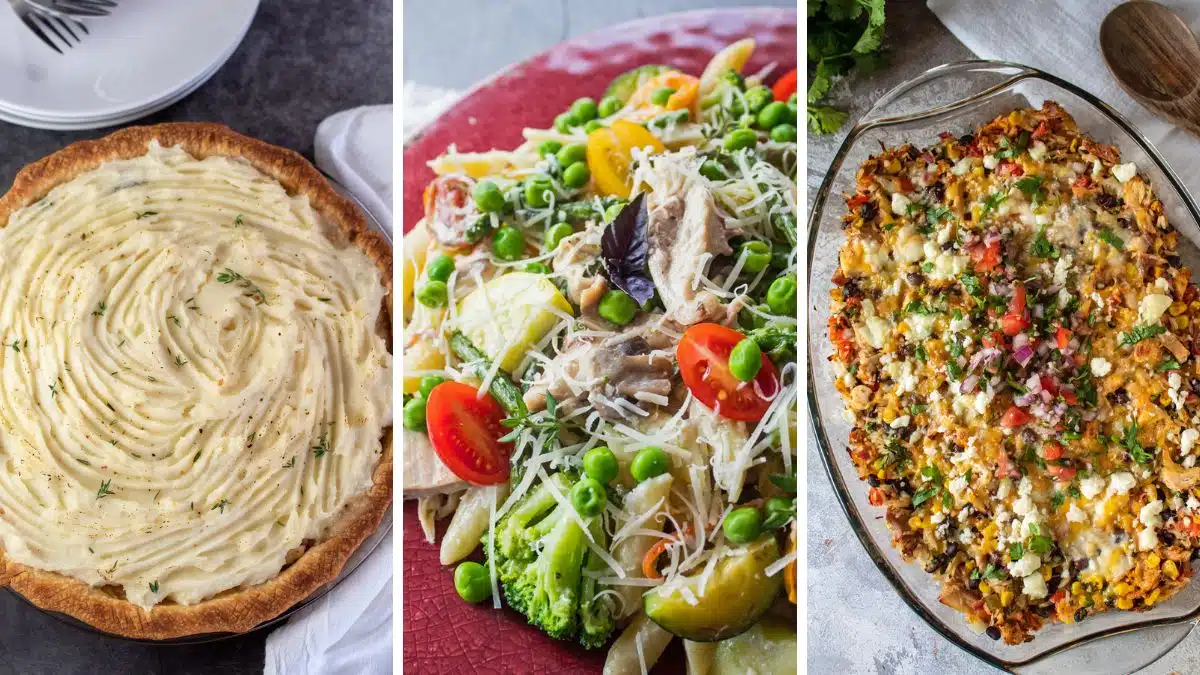
🦃🥧🍂 Great Thanksgiving Collections
- Easy Thanksgiving Desserts
- Thanksgiving Stuffing Recipes
- Thanksgiving Dinner Rolls & Bread
- Top 10 Thanksgiving Recipes
- Budget Thanksgiving Menu Ideas
- Last-Minute Thanksgiving Side Dishes
Do you love a recipe you tried? Please leave a 5-star 🌟rating in the recipe card below and/or a review in the comments section further down the page.
Stay in touch with me through social media @ Pinterest, Facebook, Instagram, or Twitter! Subscribe to the newsletter today (no spam, I promise)! Don't forget to tag me when you try one of my recipes!
📖 Recipe Card
Oven Roasted Turkey
Ingredients
- 14 lbs turkey (thawed)
- 1 cup butter
- 4 cubes chicken bullion
- ½ tablespoon smoked paprika
- 1 large orange (optional - quartered)
- 4 sprigs thyme (optional - fresh)
- 2 cups chicken broth
(Note: 2x or 3x only changes the ingredient list)
Instructions
- Preheat oven to 450°F (232°C/Gas Mark 8) and place a roasting rack or tray in your large roasting pan.
- Remove thawed 14 lbs turkey from packaging, as well as any packages in the cavity (neck, gizzards, heart, liver are usually inside - some turkeys also have a package of gravy base). Rinse turkey inside and out, place in the roasting pan breast side up, then pat dry.
- In a small bowl, combine melted 1 cup butter with 4 cubes chicken bullion cubes and ½ tablespoon smoked paprika. Break apart the cubes and mash them to make a paste.
- Using the paste, coat the outside of the turkey as well as inside the body cavity (whether or not you will be stuffing the turkey, it adds sensational flavoring!), starting with massaging the paste into the breast and working over the legs, wings, back, and then the remaining paste inside the turkey.
- Stuff your turkey (optional) with prepared stuffing. *I do not cook our stuffing this way, as the turkey cooks more evenly when left open.
- (optional) Place a quartered 1 large orange and 4 sprigs thyme herbs inside the cavity for aroma and flavoring.
- Pour 2 cups chicken broth into the bottom of the roasting pan (water will work too; water or broth will combine with the drippings from your roasting turkey and can be used for turkey gravy base).
- Leave your turkey uncovered and place the roasting pan with seasoned turkey into the oven. Reduce the oven temperature to 350°F (175°C/Gas Mark 4) and cook for 13 minutes per pound without stuffing - or 15 minutes per pound with stuffing.
- Every 45 minutes, remove the turkey from oven and baste with the drippings and then return to the oven and allow to continue cooking. Be sure to close the oven while basting, to keep your oven temperature steady for proper roasting time.
- Remove your turkey from the oven when it reaches 155-160°F (68-71°C).
- Carefully transfer the cooked turkey to a cutting board or serving platter, cover loosely with aluminum foil, then save the drippings for gravy (if desired). Allow your turkey to rest for approximately half the roasting time (ex. 1 ½ hours resting time for a 3-hour roasting time).
Notes
- The second basting interval is when I start checking the internal temperature of my turkey with a meat thermometer. It is also when I evaluate the appearance of the skin
- Cover the turkey loosely with a sheet of aluminum foil, if needed, to keep from over-cooking the skin and turkey breast.
- To store: Leftover turkey can be refrigerated for 4-5 days in an air-tight container or frozen for up to 2 months in an airtight freezer container.

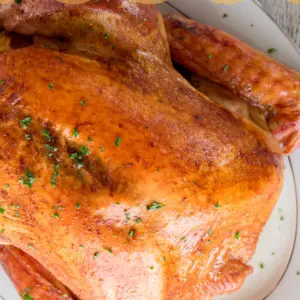
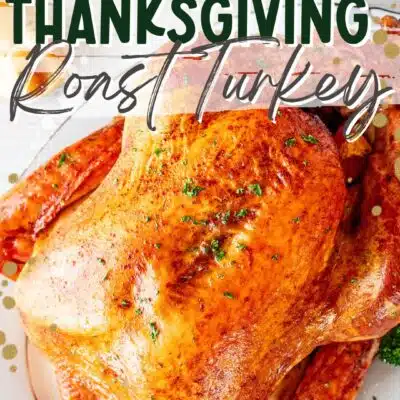
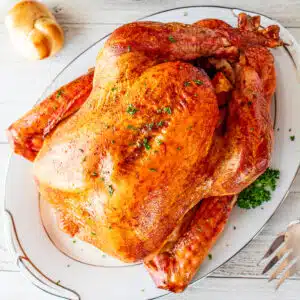
Comments
No Comments